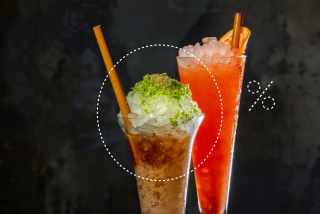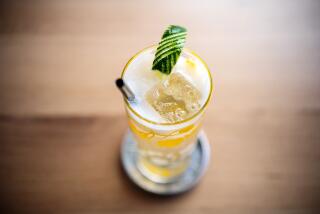Non-Alcoholic Beers... : Brewers Are Testing the Market for No Alcohol Product
- Share via
Fifteen years ago, in an age increasingly concerned about calories, beer producers brewed up a new product and before long was heard the cry, “Gimme a light.”
Today every major beer maker offers a light beer. In spite of initial skepticism over the concept, light beer now commands a major share of the beer market and, in fact, Coors Light and Miller Lite outsell those companies’ regular beers.
And now, in an age increasingly concerned about alcohol, beer makers have created yet another new product. Before long we may hear the cry, “Gimme a non.”
Non-alcoholic beer may not catch on as quickly or as strongly as did light beers after the introduction of Miller Lite in 1973, but recently a gusher of new non-alcoholic brewed malt beverages have hopped onto store shelves.
Sales are still tiny as this product fights its own image: It’s not a “soft drink,” but neither is it a beer since it has no alcohol. Still, some producers are already using Madison Avenue terms, referring to “segmentation” of the tiny non-alcoholic beer market into regular and premium categories.
The benefits of this product are obvious. At the top of the list with some people is that it’s a “safe” beverage, and thus socially acceptable to consume all night and still get behind the wheel. It’s an alternative to drinking gobs of real beer and then driving. (A recent survey by the Justice Department of people arrested and jailed for drunk driving showed that more than half said they had consumed only beer.)
Fewer calories are another benefit. Standard beers have between 100 and 150 calories a can;light beers have about 90 to 100 calories. Non-alcoholic beers have 60 to 75 calories.
John Cunin, owner of Masa’s restaurant in San Francisco, said there are other reasons to carry non-alcoholic beers:”People with ulcers or diabetes, or those who won’t drink alcohol for moralistic or religious reasons are candidates for an alcohol-free beverage.”
One drawback consumers talk about is quality. Taste the non-alcoholic beers and you’ll find most are relatively lifeless duds. Aromas are usually only fair and taste is often watery, lacking any depth. If these beverages ever take off, one wonders if we’ll hear commercials advertising that they are “really less filling;tastes, uh, OK.”
But when non-alcoholic beers were offered to three people who consume beer regularly--and straight from the container--not one noted a major difference in taste between the non and their regular beer.
Still, America has yet to take to this new beverage the way Europeans have. Of the approximately three dozen non-alcoholic beers sold in the United States today, only a handful are brewed here.
“We see so many from Europe because countries over there are far ahead of us in restricting drinking and driving,” said Joseph Owades, a longtime brewing industry consultant.
“The concept of the designated driver is fully ingrained in their society. Of the four or five people in the car, one is the designated driver, and that’s 20%to 25% of the (off-sale) market.”
And he said interest in non-alcoholic brews in the United States is growing. Among his clients, he said, are two large companies both working to produce non-alcoholic beer. He declined to name the firms.
“I think non-alcoholic beer some day will be an enormous seller,” he said.
Wall Street is thus far flatly unimpressed by the potential for growth in the non-alcoholic beer field.
Emanuel Goldman of PaineWebber,San Francisco, one of the nation’s leading beverage industry analysts, said he has done no research whatever into non-alcoholic beer. Not one of his clients had ever mentioned the subject.
“The field is very small,” he said. “People like soft drinks a lot--a quarter of all beverage consumption is soft drinks, and even beer is (a smaller market)than soft drinks.
“Soft drinks have everything:they are carbonated, they have texture, they’re sweet, and they’re cross-cultural. That doesn’t mean there isn’t a place for it (non-alcoholic beer), but in terms of it being a growth segment, there’s no evidence that it will happen.”
He said a number of large companies are doing research into non-alcoholic beer--”they’d be derelict if they didn’t”--but he said he knew of no plans by a major American beer company to enter the non-alcoholic beer field.
However, Anheuser-Busch is test-marketing a product called LAX that is a non-alcoholic beer. Moreover, the St. Louis-based brewing company still has on the market another product, introduced in 1984, called LA that is a low-alcohol beer.
Anheuser-Busch has made no public announcement of its non-alcoholic beer plans, according to Jeff Davis of Fleischman-Hilliard Public Relations in St. Louis. But Davis did confirm that LAX was in test market.
Brooks Firestone, heir to the tire fortune and a Santa Barbara County wine maker, has entered into a joint venture to produce Firestone, a non-alcoholic beer.
Firestone said Goldman’s financial appraisal of the non-alcoholic beer category may be accurate:”It is going to be an infinitesimal part of the (beer)market for a while, but that market is a giant market.
“Ten million cases of non-alcoholic beer are sold annually, which is much less than 1%of all beer sold. And of that, only about 2 million cases are in the premium category.” He said Firestone is a premium product and thus has few real competitors.
“Financial analysts don’t look at it (the non-alcoholic beer segment)because it’s so small. But my perception is that that tiny segment is very interesting and potentially profitable, even though it wouldn’t be profitable to a Miller (Brewing Co.).”
Firestone said he and partners Hale Fletcher and Michael Lewis are aiming to place Firestone in restaurants and bars, targeted at the alternative drinker, someone who wants something that isn’t sweet but has no alcohol. He said his main competitors are European beverages such as Moussy, Kaliber, Clausthaler and Warteck.
“When we go head-to-head with them (he said later the pun was not intended), with a person who has an open mind, we do very well.” (Firestone finished first in the Los Angeles Times evaluation of a group of 10 such products evaluated for this story.)
How well are non-alcoholic beers doing in the market?Fair, according to an informal survey of restaurants in Los Angeles, San Francisco and San Diego.
Silver Grille in Sherman Oaks, Tosh in Santa Monica, and Lawry’s California Center in Los Angeles all said they carry no non-alcoholic beers. La Frite in Sherman Oaks said it stocks Warteck;72 Market in Venice carries Clausthaler, and Pioneer Boulangerie in Santa Monica has Kaliber, a successful Guinness import.
The Chronicle in Pasadena was the only restaurant surveyed that carried two non-alcoholic beers: Moussy and Firestone.
In San Diego, Cafe Pacifica carries Kaliber, but Stefano’s and Silas St. John carry none.
Said Steve Zolezzi of Stefano’s:”We had one once, but it didn’t sell, so I dropped it.”
Derek Ridgway of Silas St. John said, “We sell so much wine, we don’t even get a call for regular beer any more.”
In San Francisco, such famed night spots as Tadich Grill, Square One, Hayes Street Grill and Donatello all said they carried none of the non-alcoholic brews. But the Waterfront and Masa’s both carry Kaliber, and Scott’s Seafood carries Clausthaler.
At the Waterfront on Pier 7, general manager Robert Mendoza said he chose Kaliber “because I drink it myself, and people say it tastes like beer, which makes it better than a lot of the others. It’s the closest one to beer we’ve seen. It has a good head and tastes good.” (Firestone hasn’t been formally released in San Francisco.)
Interestingly, both Cunin and Mendoza said they don’t see the so-called designated driver as the main buyer of the non-alcoholic beers. They said the primary buyer is someone who has already had a few regular drinks and just wants to taper down.
“The designated driver is usually the person who comes in and will have one Anchor Steam (beer), or one glass of Champagne, and then quit,” Cunin said.
Steve Lawrence, director of Mothers Against Drunk Driving, based in Hurst, Tex., said MADD encourages restaurants and bars to offer non-alcoholic beverages and so-called “mocktails” as an alternative to those who desire them, especially designated drivers.
And he said he had heard of some bartenders who serve non-alcoholic beers to patrons as the last beer of the evening, sometimes not even charging for them, as a way to eliminate that “one for the road” without leaving a patron still thirsting.
More to Read
Eat your way across L.A.
Get our weekly Tasting Notes newsletter for reviews, news and more.
You may occasionally receive promotional content from the Los Angeles Times.










